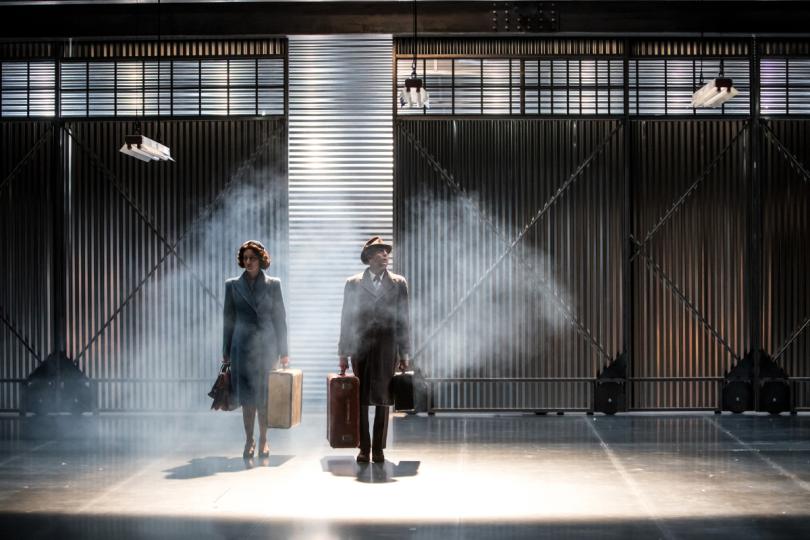The Moving Company and the American Theatre’s Patriarchy

Opening night of Refugia was an exciting night, not only for the Guthrie Theater, but for the theatre community at large. On the Wurtele Thust stage, The Bluest Eye was entering closing weekend of its triumphantly powerful production that explored black identity and self-worth. On the top floor, Mu Performing Arts was continuing its critically acclaimed showing of Charles Francis Chan Jr.'s Exotic Oriental Murder Mystery.
Across all of the Twin Cities, we are seeing a wave of dynamic work on local stages. The searing, relevant Vietgone had just closed at Mixed Blood Theatre. Ten Thousand Things is putting on a beautiful production of Intimate Apparel in their signature, barebones way. Even outside of the Twin Cities, there was a fierce production of Wit happening at Artistry in Bloomington where Sally Wingert gave one of the best performances of the year thus far.
So, of course, the theatre community was abuzz when these highly-regarded artists presented their world premier play at our most revered flagship theater. Actually, Moving Company artistic director Dominique Serrand does not refer to it as a play. “I wouldn’t call it a play, by the way.” says Serrand in the MinnPost interview, “We call it an epic journey.”
Unfortunately, the only thing epic about Refugia is the complete lack of awareness of its problematic nature. From beginning to end, it is a production that feels like yet another story that was told from the perspective of individuals who are in a bubble. More specifically, a bubble of elite artisans who placed enormous priority in the overall quality of their artistic vision and not nearly enough focus on the layered struggle of people who are fighting to survive.
This mindset, perhaps, started in the workshop period where other artists outside of the Moving Company were invited to help lend their talents to the creation of the piece. Meghan Kreidler, a rising star recently featured in productions such as Vietgone and Flower Drum Song, was a participant of the Refugia workshop. She learned quickly that this was not going to be a place of positive, inclusive creation. “The workshop lasted for three weeks, but I spent most of that time on the outside watching.” Kreidler recalls. “When I was utilized, it felt like I was just there to fill in blanks, to help move the white characters' narratives forward, but without really having any voice or significance within those scenes."
There were several moments within the workshop period where Kreidler felt apprehensive while fulfilling the tasks being asked of her. She had trouble giving voice to her concerns and instead let it bottle up inside. When she reflects on the experience now she feels like she understands why this happened: the piece itself was failing to offer her a voice, so she didn't feel like there was a place for her voice to be expressed within its creation. "When you're working in a building like the Guthrie, it can be intimidating. That intimidation is amplified by the fact that you're sharing a room with arguably some of the most incredible theater artists in the country. But when no one on the artistic side of the table is able to recognize the problems within the piece, then as someone on the other side you feel like you are not being reflected, you feel like something must be wrong with yourself if you have to be the first person to bring up how you don't feel comfortable wearing a hijab, or how you don't find humor that belittles and ostracizes people of color to be funny or intelligent. Everyone else is laughing, why aren't you? It can be very isolating."
And, therein lies a major issue within the culture of the American Theatre. The value of artistic excellence overrides the integrity of the storytelling itself; the idea that the art can be so great that the authentic truth within the art is secondary. I would imagine that when considering how to best feature your Tony-Award winning company members, you find ways to incorporate them into a story that doesn’t really concern them.
For example, Refugia begins and ends with words from an elderly white man who finds himself absorbed into a nursing home. This character is played by Steve Epp, longtime collaborator of Serrand and The Moving Company. While I sympathize for a character distraught by the perils of a nursing home, I have trouble connecting this experience to that of a refugee who is desperately seeking a home. Even though Epp delivers the beginning and ending speeches beautifully, I’m left wondering why he is the one providing us with this knowledge. This show is three hours long. In a story solely about the importance of a refugee’s desperate need to find a home, did we really need this man’s perspective at the beginning and end of a story that could most certainly be told without him?
Then, I begin to wonder why the people of color say so little in this production. Out of nine scenes throughout the piece, you could generously argue that people of color vocalize their agency in four of them. Then, when these folks are indeed getting that opportunity, the text is so incredibly heavy-handed and dense that it does not feel as though we are meeting fully realized, specific human beings. Rather, we are seeing generalized arch-types that feel forced and dangerously vague.
Now, one of my favorite scenes in the show focuses on two Jews fleeing their home to seek safety in Israel. This scene, in particular, feels the most complete with characters that are furthest in their development. It also happens to be one of the longest scenes, leading us into the intermission. No surprise, though, that the only characters who speak in this scene are the characters played by members of the Moving Company. Nathan Keepers and Christina Baldwin play the couple with great honesty but, again, the artistic indulgence of this section begins to override the cohesion of the story as the scene overstays its welcome and you feel relieved that intermission has arrived.
We want so badly to tell these significant stories that we do whatever it takes to make it happen. Even if it means that we don’t include those that know these stories firsthand. In the previously noted MinnPost article, Serrand is quoted saying that he spoke to people who knew refugees. However, he did not actually ever speak to any refugees personally. In a talk back after a performance of Refugia, Serrand was asked if he had approached any refugees about their experience. In response, Serrand said that he hadn’t. I’m not sure how that is even an option. With all your resources, all your grant money, how do you go forth telling the stories of refugees and not ask a single one of them about their experience? Especially here in the Twin Cities where we are surrounded with a massive population of immigrants and refugees, how do you not step outside your bubble of artists and seek their perspective?
By telling this complex story without that pivotal source, The Moving Company presented a blurred look into the lives of these characters. Barely scratching the surface, this piece suffers from trying to address too much with too little wind at its back. Hopefully, going forward, the artists at the helm of this work will find value in voices outside of their own.




